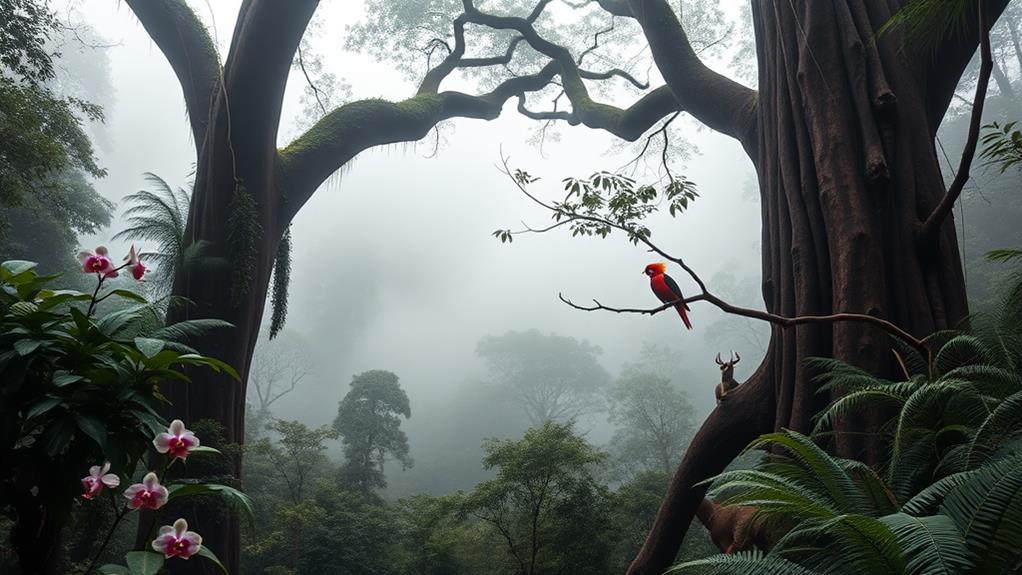Mount Makiling Forest Reserve is a 4,244-hectare biodiversity hotspot. This Key Biodiversity Area is home to over 1,000 plant species, with 28% of them found only in the Philippines.
The reserve features diverse ecosystems, including montane, lowland, and grassland. These ecosystems support a wide range of species, such as 416 species of ferns and flowering plants, 117 vertebrate species, and 118 arthropod species.
The reserve is a haven for 84 bird species, 12 mammal species, and 21 amphibians and reptiles. For example, the Philippine eagle, a critically endangered species, inhabits the forest.
Despite its importance, the reserve faces pressures threatening its ecological balance, including deforestation and climate change.
Efforts are underway to preserve its rich biodiversity, such as reforestation programs and conservation initiatives.
Unveiling Mount Makiling's Biodiversity

Mount Makiling Forest Reserve: A Treasure Trove of Biodiversity
The Mount Makiling Forest Reserve is a 4,244-hectare haven hosting over 1,000 plant species, with 28% being endemic to the Philippines. This highlights the critical significance of Mount Makiling for biodiversity conservation.
Ecological Diversity
A rapid biodiversity assessment reveals the reserve's ecological diversity, featuring 416 species of ferns and flowering plants, 117 vertebrate species, and 118 arthropod species.
This diverse ecosystem comprises montane, lowland, and grassland vegetation types, making it a priority area for biodiversity conservation.
Unique Fauna
The reserve supports threatened species, including the Philippine Eagle-Owl and the Philippine pygmy fruit bat.
These species emphasize the need for conservation efforts to protect them from habitat destruction and human activities.
Conservation Priorities
50 species within the reserve require high priority protection due to threats from habitat destruction and human activities.
It's essential to prioritize conservation efforts to protect Mount Makiling's rich biodiversity, particularly its endemic and threatened species.
Forest Reserve's Ecological Significance
Mount Makiling Forest Reserve's ecological significance is rooted in its diverse ecosystems, which encompass montane, lowland, and grassland vegetation types. This reserve spans 4,244 hectares, making it a priority area for biodiversity conservation.
The reserve is home to over 1,000 plant species, with 28% of them being endemic to the Philippines, showcasing its rich floral diversity and ecological significance. A rapid biodiversity assessment conducted in the reserve recorded 416 species of ferns and flowering plants, 117 vertebrate species, and 118 arthropod species, highlighting its role as a critical habitat for diverse life forms.
The area supports various rare and endangered species, including the Philippine Eagle-Owl and Philippine pygmy fruit bat, underscoring the importance of conservation efforts to protect its unique fauna.
Ecosystem services provided by the forest, such as pollination and habitat maintenance, are essential for maintaining ecological health and biodiversity in the region.
Unique Flora and Fauna Species

Mount Makiling's Unique Flora and Fauna Species
Mount Makiling's forest reserve is renowned for its exceptional biodiversity, boasting over 1,000 plant species, including endemic species like Rafflesia manillana and Medinilla magnifica. These species significantly contribute to the area's rich biodiversity.
The reserve is also home to rare fauna, such as the endangered Philippine Eagle-Owl and the Philippine pygmy fruit bat, which are highly restricted to original rainforest habitats.
A rapid biodiversity assessment in the area recorded 416 species of ferns and flowering plants, with approximately 28% of these being endemic to the Philippines.
The reserve's unique ecosystems support diverse vertebrate populations, including 84 bird species, 12 mammal species, and 21 amphibians/reptiles.
The presence of these unique species highlights the ecological significance of Mount Makiling, which is a haven for endemic species.
13 evaluated species are classified as high priority for conservation under the Localized Conservation Priority Index (LCPI). This underscores the importance of preserving Mount Makiling's biodiversity.
Conservation Challenges and Threats
Mount Makiling's forest reserve has been severely compromised, with nearly half of its original area lost due to human activities. Deforestation, driven by agricultural expansion and urbanization, has led to habitat degradation and loss of biodiversity. For instance, the clearing of land for farming and settlements has resulted in the destruction of natural habitats, causing many species to disappear.
Illegal logging activities have further exacerbated the problem, resulting in the loss of precious timber and habitat destruction.
Moreover, invasive species have disrupted the balance of native flora and fauna, threatening the survival of endemic species found within the reserve. For example, the introduction of non-native plant species has outcompeted native plants for resources, leading to a decline in native plant populations.
Climate change also poses a significant threat to the reserve, altering rainfall patterns and rising temperatures, which exacerbate existing ecological vulnerabilities within the forest. This has led to changes in the distribution and abundance of species, making it difficult for some species to adapt and survive.
Pollution from nearby urban areas compromises water quality, affecting the delicate habitats that support diverse wildlife in Mount Makiling. For instance, the pollution of rivers and streams has led to the decline of aquatic species, which are essential components of the ecosystem.
These conservation challenges and threats pose a significant risk to the reserve's biodiversity, highlighting the urgent need for effective conservation strategies to protect this unique ecosystem.
Preserving Endemic Plant Species

Mount Makiling's forest reserve is home to a significant number of endemic plant species, which are unique to the Philippines. Specifically, 28% of the reserve's flora is found only in the Philippines, highlighting the area's ecological importance.
These endemic species thrive in diverse ecosystems, including montane and lowland rainforests. For example, notable species such as Rafflesia manillana, Medinilla magnifica, and Diplodiscus paniculatus are found in these ecosystems.
These ecosystems support the growth of various endemic flora that play crucial roles in maintaining ecological balance.
However, these species are threatened by illegal logging and habitat degradation. To combat these threats, ongoing research and monitoring programs are documenting plant diversity and assessing conservation needs. This research ensures the protection of endemic species within the forest reserve.
By preserving these endemic plant species, we're contributing to the overall conservation of Mount Makiling's biodiversity. This is critical for maintaining the ecological balance of the reserve and preserving its unique flora.
Exploring Ecosystem Services
Mount Makiling's ecosystems provide essential services that benefit both the environment and local communities. These services support biological diversity and human well-being.
One of the key ecosystem services is the enhancement of floral reproduction through pollination. For example, the presence of Apis breviligula Maa, a species of bee, contributes to the overall biodiversity of the forest.
The forest reserve also functions as a critical watershed, regulating water supply and maintaining hydrological cycles for surrounding communities in Laguna and Batangas.
Additionally, Mount Makiling's ecosystems provide carbon sequestration, capturing and storing atmospheric carbon dioxide, which contributes to climate regulation.
The area supports a variety of non-timber forest products, providing economic benefits to local communities, with an average household income estimated at P1,490 per year.
Furthermore, the biodiversity in Mount Makiling enhances soil fertility and stability, supporting agricultural productivity and preventing erosion, which is vital for sustainable land use practices.
Cultural Significance and Community

Mount Makiling's cultural significance extends beyond its ecological importance, with the local deity Mariang Makiling deeply ingrained in folklore and community identity. This connection fosters a strong bond between locals and the natural environment.
Cultural practices enrich community identity and promote ecological awareness. For instance, the Mariang Makiling legend promotes ecological awareness, while festivals and traditions educate residents and visitors about biodiversity and ecosystem preservation. These cultural activities not only enrich cultural identity but also encourage community engagement.
Community engagement is crucial for conservation efforts. By promoting cultural significance, community involvement is encouraged through proposed frameworks aimed at raising public awareness about biodiversity and its significance to cultural heritage.
For example, non-timber forest product (NTFP) harvesting supports sustainable practices and provides economic benefits to local communities, with an average income of P1,490 per year.
Embracing cultural significance contributes to a deeper connection between locals and the natural environment. By recognizing the importance of cultural practices, community engagement is enhanced, and biodiversity preservation is supported. This, in turn, ensures the continued provision of ecosystem services.
Ecotourism and Sustainable Practices
Mount Makiling: A Hub for Ecotourism and Sustainable Practices
Located approximately 65 km from Metro Manila, Mount Makiling is an accessible destination for tourists, enabling sustainable tourism practices that benefit local communities economically. This forest reserve offers a range of activities designed to promote biodiversity conservation and sustainable practices, making it an ideal haven for ecotourism.
Educating Visitors on Biodiversity Conservation
Ecotourism initiatives within Mount Makiling focus on educating visitors about the importance of biodiversity conservation. Activities are designed to minimize environmental impact and foster responsible tourism.
For instance, visitors can participate in guided tours that highlight the significance of preserving the area's unique flora and fauna.
Supporting Local Communities through Sustainable Practices
Local communities engage in sustainable practices, such as harvesting non-timber forest products (NTFPs), which contribute to an average household income of P1,490 per year.
This income supports the local economy and promotes the conservation of Mount Makiling's natural resources.
Conservation Efforts through Eco-Tourism Revenues
Conservation efforts are supported through eco-tourism revenues, which fund research, habitat restoration, and protection initiatives.
This ensures the preservation of the area's unique flora and fauna.
Ongoing Research and Monitoring

Mount Makiling Forest Reserve is a biodiversity hotspot, with approximately 416 species of ferns and flowering plants recorded in the crater area. Ongoing research and monitoring are crucial in this reserve, as they enable continuous biodiversity assessments to track species richness and distribution.
To achieve this, the Permanent Biodiversity Monitoring Area (PBMA) was established, following international protocols to monitor ecological changes and biodiversity health over time. Regular surveys are essential in documenting endemic species, with over 28% of plant species found in the reserve being endemic to the Philippines.
Monitoring programs also assess the impact of human activities, such as illegal agriculture and poaching, on biodiversity. These efforts have identified 50 evaluated species, with 13 classified as high priority for conservation.
A GIS-based geodatabase has been developed to support management decisions, containing vital data on soil types, elevation, and land use to facilitate ongoing research and conservation efforts.
Protecting a Biodiversity Hotspot
Mount Makiling Forest Reserve is a critical site for biodiversity conservation. This 4,244-hectare Key Biodiversity Area (KBA) and ASEAN Heritage Park in the Philippines is home to over 1,000 plant species, with approximately 28% being endemic to the Philippines. This highlights its importance for preserving unique flora.
Threats to the biodiversity hotspot include deforestation, illegal logging, and human activities, which jeopardize the habitat of numerous endemic and threatened species. To protect this biodiversity hotspot, conservation efforts are essential.
Local communities are engaged in conservation initiatives, which include eco-tourism. This not only provides funding but also raises awareness about the importance of protecting Mount Makiling's biodiversity.
Frequently Asked Questions
What Is the Biodiversity of Mount Makiling?
Mount Makiling boasts an impressive array of biodiversity, with over 1,000 plant species and 117 vertebrate species.
This ecological hotspot is home to the Philippine Eagle-Owl and other unique species like Rafflesia manillana and Medinilla magnifica, which are found only in this region.
The conservation of these habitats is crucial, as 28% of the 416 recorded species are endemic to the Philippines and can be found nowhere else.
The reserve features four distinct vegetation types, each supporting unique ecosystems that underscore the importance of preserving this biodiversity haven.
What Is Special About Mount Makiling?
Mount Makiling stands out due to its exceptional features.
It is an ASEAN Heritage Park, showcasing exemplary forest management that supports a rich array of plant and animal species.
This unique blend of natural wonders and conservation efforts is characterized by four distinct vegetation types, including dipterocarp, mossy, savanna, and agro-ecosystems, which create diverse ecosystems.
As a result, Mount Makiling serves as a valuable training laboratory for forestry and plant sciences, providing hands-on learning opportunities for students and researchers.
What Is the Forest Cover and Biodiversity Profile of the Crater Area of Mt Makiling Luzon?
The crater ecosystem of Mt. Makiling's crater area is a biodiversity hotspot. This unique ecosystem features a rich profile with 416 species of ferns and flowering plants.
117 vertebrate species, including 84 bird species and 12 mammal species, call this ecosystem home.
About 28% of the plant species are endemic, highlighting the region's distinct biodiversity.
Conservation efforts focus on protecting these endemic species and the ecosystem's complexity, making the crater area a critical site for preservation.
What Type of Forest Is in Mount Makiling?
Mount Makiling is home to several distinct forest types. These include upper montane rain forest, lower montane rain forest, lowland evergreen rain forest, and parang vegetation.
Each of these forest types supports a unique set of plant and animal species. For example, the upper montane rain forest is characterized by a dense canopy and is home to a variety of orchids and ferns. The lower montane rain forest, on the other hand, has a more open canopy and is inhabited by species such as the Philippine python and the monitor lizard.
The conservation of these forest ecosystems is crucial to preserve the rich biodiversity of the area and ensure the long-term health of the ecosystem.